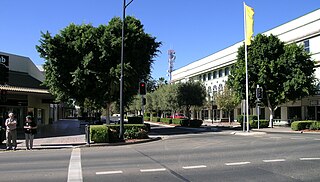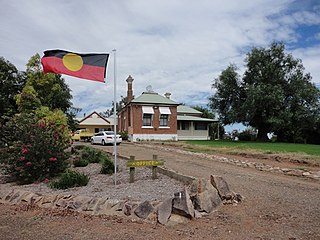
Lismore is a city located in the Northern Rivers region of New South Wales, Australia and the main population centre in the City of Lismore local government area, it is also a regional centre in the Northern Rivers region of the state. Lismore is 734 km (456 mi) north of Sydney and 200 km (120 mi) south of Brisbane. It is situated on a low floodplain on the banks of the Wilsons River near the latter's junction with Leycester Creek, both tributaries of the Richmond River which enters the Pacific Ocean at Ballina, 30 km (19 mi) to the east.

Moree is a town in Moree Plains Shire in northern New South Wales, Australia. It is located on the banks of the Mehi River, in the centre of the rich black-soil plains. Newell and Gwydir highways intersect at the town. It can also be reached from Sydney by daily train and air services.

Ballina is a town in the Northern Rivers region of New South Wales, Australia, and the seat of the Ballina Shire local government area. It lies 740 km (460 mi) north of Sydney and 185 km (115 mi) south of Brisbane. Ballina's urban population at the end of 2021 was 46,190.

Mullumbimby, locally nicknamed Mullum, is a town in the Byron Shire in the Northern Rivers region of New South Wales, Australia. It promotes itself as "The Biggest Little Town in Australia". The town lies at the foot of Mount Chincogan in the Brunswick Valley about 9 kilometres by road from the coast. At the 2021 census, Mullumbimby and the surrounding area had a population of 3,589 people. It is known for its hippie subculture, and it has been referred to as "Australia's anti-vaxxer capital".

Kempsey is a town in the Mid North Coast region of New South Wales, Australia and is the council seat for Kempsey Shire. It is located roughly 16.5 kilometres inland from the coast of the Pacific Ocean, on the Macleay Valley Way near where the Pacific Highway and the North Coast railway line cross the Macleay River. It is roughly 430 kilometres north of Sydney. As of June 2018 Kempsey had a population of 15,309 (2018).
Lemon Tree Passage is a suburb of the Port Stephens Local Government Area in the Hunter Region of New South Wales, Australia, located at the end of the Tilligerry Peninsula and surrounded by the waters of Port Stephens. At the 2021 census it had a population of 2,686. It is a haven for koalas due to it being densely wooded. The town has a small marina and the local industry is oyster farming.

Lennox Head is a seaside village in the Northern Rivers region of New South Wales, Australia, situated on the stretch of coast between Byron Bay and Ballina in Ballina Shire local government area. It had a population of 7,741 in the 2016 Australian census.

Woodburn is a small highway town on the banks of the Richmond River in New South Wales, Australia. Until the town was bypassed in September 2020, the busy Pacific Highway passed through the centre of town. Woodburn is 712 km north of the state capital, Sydney, and 34 km south of the regional city of Lismore.
The NAISDA Dance College is a performing arts training college based in Kariong, New South Wales for Aboriginal and Torres Strait Islander people in Australia. It was established as the Aboriginal Islander Skills Development Scheme (AISDS) in 1975, which became the National Aboriginal and Islander Skills Development Association (NAISDA) in 1988. The date of establishment of the college is usually cited as 1976, although some sources report it as 1975.

Ballina Shire is a local government area in the Northern Rivers region of New South Wales, Australia. The Shire was formed on 1 January 1977 by the amalgamation of the Municipality of Ballina and Tintenbar Shire. The Shire is located adjacent to the Tasman Sea and the Pacific Highway. The council seat is located in the town of Ballina. The population of the Ballina Shire area was 46,850 in 2022.
Richmond River High Campus, formerly known as Richmond River High School, is an Australian secondary school located in North Lismore, in the Northern Rivers region of New South Wales. It is a dual-campus government-funded co-educational comprehensive secondary day school, and part of The Rivers Secondary College.

The Bundjalung people, also spelled Bunjalung, Badjalang and Bandjalang, are Aboriginal Australians who are the original custodians of a region from around Grafton in northern coastal New South Wales to Beaudesert in south-east Queensland. The region is located approximately 550 kilometres (340 mi) northeast of Sydney and 100 kilometres (62 mi) south of Brisbane that now includes the Bundjalung National Park.

Wardell is a village in the Northern Rivers region of New South Wales, Australia. It is situated on the Richmond River and the Pacific Highway between Broadwater and Ballina. Wardell is approximately 724 km (450 mi) north of Sydney and 200 km (124 mi) south of Brisbane. The boundaries are within the Ballina Shire local government area.

Mooball is a locality in the Tweed Shire, New South Wales, Australia and it is on the lands of the Bundjalung people who are its Traditional Owners. The town name was originally spelt Moball.

The Cootamundra Domestic Training Home for Aboriginal Girls, commonly known as "Bimbadeen" and Cootamundra Girls' Home, located at Cootamundra, New South Wales, was a home and training college for Aboriginal girls during the 20th century. It operated by the NSW Government's Aborigines Welfare Board from 1911 to 1968 to provide training to girls forcibly taken from their families under the Aborigines Protection Act 1909. The only training received by the girls was to work as domestic servants, and they were not allowed any contact with their families. They were part of a cohort of Aboriginal people now known as the Stolen Generations.

Benjamin Cameron Franklin is an Australian politician. He served as a member of the New South Wales Legislative Council from March 2015 until March 2019, representing the National Party. He resigned in 2019 to contest the Legislative Assembly seat of Ballina, but was defeated by the incumbent Greens MP Tamara Smith. He was subsequently appointed in May 2019 to fill the casual vacancy caused by his own resignation. Franklin served as the Minister for Aboriginal Affairs, the Minister for the Arts, and the Minister for Regional Youth in the second Perrottet ministry from December 2021 to March 2023.

South Ballina is a locality located in the Northern Rivers Region of New South Wales - bounded by the Richmond River to the north, the Tasman Sea to the east, and Keith Hall to the south and west. Across the river to the north, is the town of Ballina and it is a popular spot for recreational fishing. It is on the lands of the Bundjalung Nation and it falls within the Jali Aboriginal Land Council.
Albert Digby Moran (1948–2020) was an Australian Aboriginal artist. His work derived inspiration from his Bundjalung ancestors in the north of New South Wales, Australia, where he remains one of the Northern Rivers' most recognised artists.
Rhoda Ann Roberts is an Australian theatre and arts director and arts executive. She was head of Indigenous programming at the Sydney Opera House from 2012 until 2021, among many other roles. She is also a highly respected Aboriginal elder, being afforded the title "Aunty".

The 2022 eastern Australia floods were one of the nation's worst recorded flood disasters with a series of floods that occurred from late February to early May in South East Queensland, the Wide Bay–Burnett and parts of coastal New South Wales. Brisbane suffered major flooding, along with the cities of Maryborough, Gympie, the Sunshine Coast, Caboolture, Toowoomba, Gatton, Ipswich, Logan City, the Gold Coast, Murwillumbah, Mullumbimby, Grafton, Byron Bay, Ballina, Lismore, the Central Coast and parts of Sydney.















